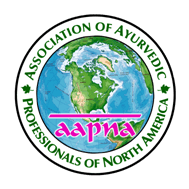Ayurveda, literally translated from Sanskrit as “the science of life”, is the ancient (over ten thousand years old), traditional, natural system of medicine of India; it is considered by the National Center for Complementary and Alternative Medicine to be a whole medical system, a complete system of theory and practice that has evolved over time in a different culture and apart from conventional or Western medicine. Ayurveda is based upon a deep communion with the spirit or nature of life itself. Following the principles of Ayurveda confers a profound understanding of the movement of vital force or energy and its manifestations within the entire mind-body system.
According to the writings of India’s great sages, seers and yogis, Ayurveda has its roots in the very beginning of cosmic creation. Vedic seers state that Ayurveda originates from the creative intelligence behind the universe, from which the entire manifest world comes into being out of immanifest cosmic laws.
Since Ayurveda recognizes a common origin for the universe and for humanity, Ayurveda teaches that nature consists of three primary qualities called gunas. These three gunas – Sattva, Rajas and Tamas – are inner qualities that exist behind all material forms in nature. Another great theory is of the five gross elements (Panchamahabhutas) – space, air, fire, water, and earth – and that the entire universe is governed and composed of these five elements. The entire physiology is made up of seven tissues (Dhatus) – plasma, blood, muscle, adipose tissue (fat), bone, bone marrow, and reproductive tissue. From the sap of all tissues, Ojas, the ultimate refined product of digestion and metabolism, which connects one’s physiology with consciousness and is responsible for greater immunity, is formed.
The five elements described above form three biological humors (Doshas) – Vata, Pitta and Kapha. Every living being is a balance of the three doshas in different and unique proportions and manifestations. Vata dosha is responsible for movement and communication, and it represents all neurological activities in the body. Pitta dosha is responsible for the transformation, digestion and metabolism of food and nutrients, and governs all hormonal and enzymatic actions. Kapha dosha is responsible for structure, cohesion, binding and lubrication, and governs all immunological activities and structural functions.
No, not at all. Ayurvedic principles are simple, natural and universal, and anybody can incorporate them into his or her daily life. There is no need to become religious in order to adopt the principles of Ayurveda.
Classical Ayurvedic texts describe three types of foods – Sattvic, Rajasic and Tamasic. Sattvic foods consist of fresh, energizing foods such as leafy vegetables, fresh fruits, milk, yogurt, butter, honey and others. According to Ayurveda, Sattvic foods are recommended for everyone. Rajasic foods consist of hot and pungent foods such as meat, beans, chilies and more. A diet which includes more Rajasic foods is considered suitable only for those who engage in heavy physical work. Finally, a Tamasic diet includes fermented and highly processed foods, stale or old foods, and alcoholic drinks. A Tamasic diet is considered to be harmful to health and is not recommended for anyone. Ayurveda lays emphasis on diet and lifestyle routines for optimum health, and therefore, Sattvic food, moderate physical exercise, exposure to fresh air and sunlight are all recommended.
Ayurveda Wellness Center offers a simple Ayurvedic Holistic Health Analysis Questionnaire. The questionnaire will help to determine your unique Prakriti (Ayurvedic mind-body constitution) as well as help to analyze any current imbalances. Please email me at doctorshekhar@gmail.com or call 484.347.6110 to request a copy of the questionnaire.
Overweight and obesity are caused by a variety of factors, including but not limited to a poor diet, overeating, lack of physical activity, and hormonal imbalances. Ayurveda considers obesity to be an excess accumulation of Kapha in the body. Ayurveda addresses the need to correct imbalances in the physiology through natural means such as dietary changes, exercise, self-massage, gentle detoxification procedures, intake of herbal food supplements and meditation. If the recommended principles and procedures are followed sincerely, one can expect to lose weight.
Cancer is regarded as a vitiation of Vata, Pitta and Kapha. Many cancer patients do seek Ayurvedic therapies for the relief or cure of various types of cancers. Depending on the severity and stage of the cancer, the earnestness of the cancer patient in following Ayurvedic treatments, and on various other factors, Ayurveda may or may not bring about relief. Please remember that Ayurveda does not claim to “cure” diseases, but to restore balance to the physiology.
According to Ayurveda, when honey is heated above 108° Fahrenheit, it becomes transformed into a glue-like substance that is extremely difficult to digest. This substance is considered a toxin (ama), since it adheres to the tissues of the body and is very difficult to remove. Many incompatible food combinations produce ama, but heated honey is one of the most difficult forms of ama to cleanse. Furthermore, not only does heating honey make it toxic and increase ama, but new research also indicates that most of the benefits of honey — a variety of amino acids, enzymes, minerals, fatty acids and carbohydrates — are destroyed by the application of heat. Therefore, Ayurveda recommends raw, unprocessed honey. Unfortunately, many natural and organic whole grain breads and other prepared products for children, such as granola bars, crackers, and cereals, contain honey which has been cooked or baked; it is best to avoid feeding these products to growing children.
Professional Ayurvedic practitioners in the U.S. are currently not authorized to submit claims to health insurance companies for personal Ayurvedic consultations, and can only accept direct payments from their clients. However, some insurance companies may reimburse their beneficiaries for some alternative medicine services. Check with your health insurance company to find out if they will reimburse you for Ayurvedic care.
Panchakarma consists of five different physiological detoxification therapies. These are: Vamana (therapeutic emesis), Virechana (therapeutic purgation), Basti (therapeutic herbalized oil enema), Nasya (therapeutic nasal, sinus, head, brain and throat cleansing), Raktamokshana (therapeutic bloodletting). We offer a variety of affordable Panchakarma services.
Ayurvedic herbal supplements may help to improve one’s overall health, however, it is extremely important that they be taken in their compatible and complementary combinations, and that one also follows the necessary dietary and daily and seasonal recommendations for his or her particular constitution and health concerns. Recently, JAMA conducted a study which found that guggulipid had no effect on lowering cholesterol in a population of mostly Western men on a traditional Western diet. Ayurvedic doctors traditionally have never recommended that guggulu be taken alone for the reduction of cholesterol but have always taught that it must be purified and taken with other detoxifying herbs and foods. In order to get results using Ayurvedic herbal supplements, it is best to consult a professional first.
Always check with your physician or primary health care provider before altering the schedule of prescription medications you follow, or before taking Ayurvedic herbal supplements in addition to your current medications.
Unless otherwise directed by your physician or primary health care provider, it is not necessary to take additional vitamin and mineral supplements. Ayurveda recommends getting vitamins and minerals directly from the intake of nutritious foods and herbs.
Ayurveda and Yoga are complementary sister sciences, both based in Vedic knowledge. One can achieve perfect health by adopting the principles of Ayurveda and practicing Yoga regularly.
(pronounced oh-jus) is the ultimate refined result of digestion, metabolism, absorption, and assimilation.
The substance that connects the mind to the body and consciousness, it is a wholesome biochemical substance that nourishes all body tissues and has a direct influence on nature and the quality of physical, mental, and emotional life.
Ojas’ primary location is the heart, from which it circulates and pervades the whole body. Ojas is collected from the body’s seven tissues – plasma, blood, muscle, adipose tissue (fat), bone, bone marrow, and reproductive tissue (semen and ovum) — by the influence of enzymes (Agnis), similar to how a bee collects honey from the essence of many flowers.
The purest substance in the universe and omnipresent in the human being, Ojas is responsible for higher states of consciousness, purity of thoughts, perfect health, positivity in feelings, love, joy, better immunity, longevity, intelligence, creativity, memory, bliss, and thought process.
When an individual’s inner consciousness awakens spontaneously, Ojas increases. In a nutshell, Ojas is the sap of the entire physiology and sustains the life of an individual itself.
Ayurvedic herbal supplements and detoxification programs are inherently meant to amplify Ojas, and therefore to strengthen the immune system
Ama is a toxic, morbid, glue-like substance which is a result of weak Agni (digestive or metabolic fire). Ama is the primary cause for the majority of disorders and diseases.
Pulse analysis is called Nadi Vignan in Ayurveda. Ayurvedic practitioners feel the radial artery with three fingers to evaluate the balanced and imbalanced conditions of Vata, Pitta and Kapha in mind and body. All people can learn pulse analysis and practice it daily on themselves in order to gain a better understanding of their own physiology and its changes under various circumstances.
Please remember that Ayurveda does not claim to treat, prevent or cure diseases, but only to restore balance to the physiology. When balance is restored, many diseases and disorders are often automatically prevented.
Yes, the principles and theories of Ayurveda are natural. Health professionals have a greater understanding of anatomy and physiology and can easily incorporate the principles of Ayurveda into their practice. They can provide their patients and clients with lifestyle recommendations, exercises, herbal food supplements and dietary advice based on individual mind-body types and imbalances pertaining to various health conditions. By incorporating the principles of Ayurvedic medicine, health professionals can address the root causes of disorders and bring about greater and faster natural relief in their patients and clients.
The title “Vaidya” is earned through training and subsequently acquiring a deep Ayurvedic knowledge of all the aspects of healing – the physical, mental, emotional, and spiritual. In Ayurveda, dis-ease or ill-health is not treated symptomatically or on just the physical level – it is always addressed in the context of an individual’s overall constitution and takes into account personal circumstances such as profession, family life, seasonal influences, and daily habits. A vaidya is one who studies the science of life and health on individual and cosmic levels. There are several vaidyas throughout North America who have undergone extensive training in India. You may visit www.aapna.org to find a vaidya near you.









© 2021 Ojas Ayurveda Wellness Center. All Rights Reserved. Fair Use Policy. Privacy Policy.